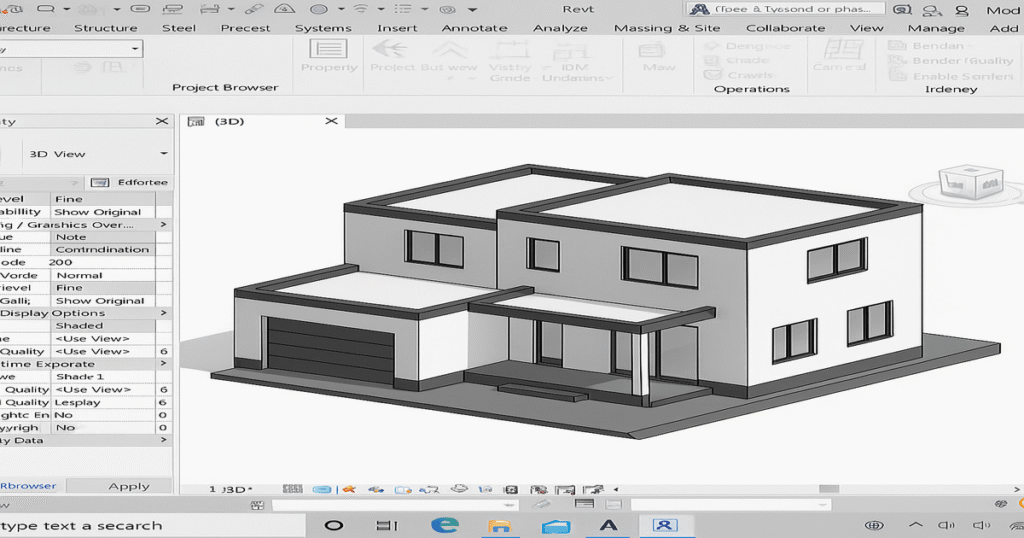Introduction
Revit is a Building Information Modeling (BIM) software developed by Autodesk, widely used by architects, engineers, and construction professionals to design, plan, and manage buildings with precision. Unlike traditional CAD software, Revit offers parametric modeling, real-time collaboration, and data-rich 3D designs, making it a powerhouse in the Architecture, Engineering, and Construction (AEC) industry.
In this comprehensive guide, we’ll answer key questions like:
- What is Revit used for?
- Can you get Revit for free?
- How does it compare to AutoCAD?
- Is Revit difficult to learn?
- What are the career opportunities and salaries?
Let’s dive in!
1. What is Revit Used For?
Revit is primarily used for:
✅ Architectural Design – Creating detailed 3D models of buildings.
✅ Structural Engineering – Designing load-bearing structures with precision.
✅ MEP (Mechanical, Electrical, Plumbing) – Planning HVAC, electrical systems, and piping.
✅ Construction Documentation – Generating floor plans, elevations, and schedules automatically.
✅ Collaboration & Clash Detection – Allowing teams to work together in real-time and detect design conflicts early.
Unlike AutoCAD (which focuses on 2D drafting), Revit is a BIM tool that integrates design, documentation, and data management into a single workflow.
🔗 Learn more about Revit’s capabilities on Autodesk’s official Revit page.
2. Can I Get Revit for Free?
Yes, but with limitations:
- Free Trial: Autodesk offers a 30-day free trial of Revit.
- Educational License: Students and educators can get free access for 1 year (renewable).
- Startup Program: Eligible startups may receive discounts.
However, a full commercial license requires a paid subscription (see pricing below).
3. Is Revit Better Than AutoCAD?
| Feature | Revit | AutoCAD |
|---|---|---|
| Purpose | BIM (3D modeling, data-driven design) | 2D Drafting & 3D CAD |
| Industry Use | Architecture, Engineering, Construction | General drafting, manufacturing |
| Collaboration | Cloud-based, real-time teamwork | Limited collaboration features |
| Automation | Schedules, quantities update automatically | Manual updates required |
Verdict: Revit is better for BIM-based projects, while AutoCAD excels in general drafting.
4. What Tool is Revit?
Revit is a BIM (Building Information Modeling) software that goes beyond 3D modeling—it includes:
- Parametric Components – Smart objects that adjust dynamically.
- Data Integration – Tracks materials, costs, and timelines.
- Interoperability – Works with AutoCAD, Navisworks, and other Autodesk tools.
It’s not just a CAD program—it’s a comprehensive project management tool for AEC professionals.
5. Is Revit Difficult to Learn?
- For Beginners: Moderate learning curve (easier if you know AutoCAD).
- For Professionals: Intuitive if experienced in BIM workflows.
- Resources to Learn:
- Autodesk’s official tutorials (Revit Learning Hub)
- Udemy/Coursera courses (~50−50−200)
- YouTube tutorials (free)
With practice, most users become proficient in 3-6 months.
6. Is Revit Good for a Job?
Absolutely! Revit skills are in high demand for:
- BIM Modelers (50K−50K−90K/year)
- Architectural Designers (60K−60K−110K/year)
- MEP Engineers (70K−70K−120K/year)
Industries hiring Revit experts:
🏢 Architecture Firms
🏗 Construction Companies
⚡ MEP Engineering Firms
7. What is the Highest Salary in Revit?
Salaries vary by role and location:
| Job Title | Average Salary (USD) |
|---|---|
| BIM Manager | 80,000−80,000−130,000 |
| Senior Architect | 90,000−90,000−140,000 |
| MEP Engineer | 70,000−70,000−120,000 |
💡 Highest-paying countries: USA, UK, Australia, UAE.
8. Who Uses Revit the Most?
- Architects (60% of users)
- Structural Engineers (25%)
- MEP Engineers (15%)
- Contractors & Project Managers (Increasing adoption)
9. Which Country Uses Revit?
Top Revit-adopting countries:
- United States (Largest market)
- United Kingdom (BIM mandate in public projects)
- Australia (Growing AEC sector)
- UAE (Dubai’s smart city projects)
10. How Much Does Revit Training Cost?
| Training Type | Cost (USD) |
|---|---|
| Online Course (Udemy/Coursera) | 50−50−200 |
| Certification Program | 300−300−1,000 |
| University Degree (BIM Focus) | $10,000+ |
💡 Free options: Autodesk’s learning portal & YouTube tutorials.
11. What Profession Uses Revit?
- Architects – Designing buildings.
- Civil Engineers – Infrastructure planning.
- Interior Designers – Space planning & visualization.
- Construction Managers – Clash detection & project tracking.
Conclusion: Should You Learn Revit?
If you’re in architecture, engineering, or construction, learning Revit is a smart career move. It offers:
✔ Better job opportunities
✔ Higher salaries
✔ Industry-standard BIM workflows

